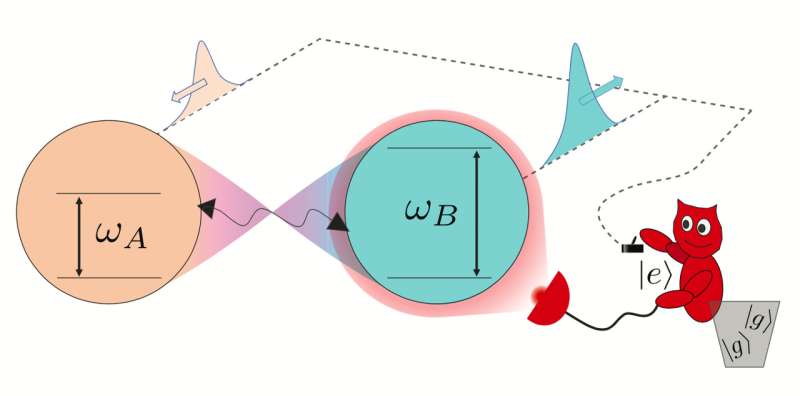April 26, 2021 feature
A two-qubit engine powered by entanglement and local measurements

Researchers at Institut Néel-CNRS, University of Saint Louis and University of Rochester recently realized a two-qubit engine fueled by entanglement and local measurements. This engine's unique design, outlined in a paper published in Physical Review Letters, could open up exciting possibilities for thermodynamics research and inform the development of new quantum technologies.
"Our paper is based on a very simple and deep effect of quantum mechanics: Measuring a quantum system disturbs the system, i.e., changes its state in a random way," Alexia Auffèves, one of the researchers who carried out the study, told Phys.org. "As an immediate consequence, the measuring device provides both energy and entropy to the quantum system, playing a role similar to a hot source fueling a thermal engine. The noticeable difference is that here, the fuel is not thermal, but quantum."
A few years ago, Auffèves and some of her colleagues at Institut Néel-CNRS introduced the proof of concept for a measurement-fueled engine based on a single qubit. This was the first of a series of proposals that revealed the energetic counterpart of measurement devices.
So far, measurement processes were typically modeled using classical theoretical approaches. In their new paper, the researchers took a bold step forward by opening 'the black box' of measuring devices and looking at it from a quantum physics perspective.
"We specifically considered the creation of quantum correlations between the system to measure and a 'quantum meter,'" Auffeves said. "We tracked the energy and entropy flows along this process, unveiling the microscopic origin of the measurement fuel. This was the most important objective of our work."
In their study, Auffeves and her colleagues thus focused on so-called 'composite systems." Their analysis ultimately led to the design of a measurement-powered engine based on entangled qubits. In addition to local measurements, this engine is fueled by a physical phenomenon known as quantum entanglement. Entanglement occurs when a set of particles interact or remain connected such that the actions performed by one affect the other, even if there is a significant distance between them.
The new engine proposed by the researchers has two qubits. A qubit is a quantum system with two energy states: the ground state |0> and the excited state |1>,
"When a qubit is measured in |1>, one can deterministically extract a quantum of energy from it, dubbed a photon," Auffèves said. "When the photon is released, the qubit is back to |0> by energy conservation. Respectively, when the qubit is in |0>, one can provide one photon to excite it in the |1> state."
Auffèves and her colleagues played with two qubits of different colors: a red one and a blue one. The red qubit exchanges red photons, while the blue one exchanges blue photons. Notably, the red qubit carries less energy than the blue qubit.
The protocol used by the researchers initially provides a red photon to the red qubit, preparing |1a > while the blue qubit is |0b>. Subsequently, the qubits interact by exchanging photons with each other, becoming entangled.
"We then measured the blue qubit," Auffeves said. "If it is measured in |0b> we are back to the initial state, and the process restarts. If it is measured in |1b> a blue photon can be extracted. Since blue photons are more energetic than red ones, one gains energy from the process on average. As we show and analyze, this energy comes from the measuring device."
The measurement-powered engine proposed by Auffèves and her colleagues relies on a composite working substance, and entanglement plays a crucial role in its fueling mechanism. The researchers were able to carry out a quantitative assessment of the two physical resources brought by quantum measurement, namely information and fuel. In addition, they examined the effects of these resources on the engine's performance.
"Our findings provide new insights into the fundamental energetic resources at play when a quantum system is measured, or equivalently, when quantum correlations are created between a quantum system and a quantum meter," Auffèves said. "Originally, these results are valid in the absence of a well-defined temperature as the only considered source of noise is measurement itself."
Auffèves and her colleagues were among the first to extend measurement-powered engines to composite working substances and to offer a microscopic interpretation of the fueling mechanism. Their findings could help to extend concepts related to thermodynamics to quantum sources of noise, such as those that can appear inside a cryostat.
In the future, the researchers' work could inspire other teams to realize similar engines. In addition, their study could open up an entirely new field of research, which they suggest could be called "quantum energetics."
"Our results shed new light on the measurement postulate in quantum mechanics," Auffèves said. "Since this mechanism still feeds fundamental debates, one can hope that quantum energetics provides new measurable quantities to distinguish between the various interpretations of quantum mechanics. On a more applied side, the energetic footprints of quantum measurement and entanglement will have an impact on the energy cost of quantum technologies and their potential for scalability."
More information: Two-qubit engine fueled by entanglement and local measurements. Physical Review Letters(2021). DOI: 10.1103/PhysRevLett.126.120605
Journal information: Physical Review Letters
© 2021 Science X Network





















